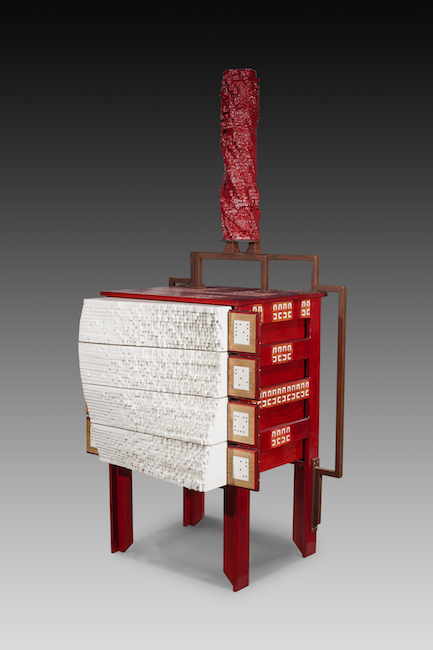
Local artist Alex Mollere creates one-of-a-kind furniture in his Mid City warehouse. Photo: Martine Chaisson Gallery
There’s an established romantic notion that’s floated around forever that an artist’s life is often one of passionate poverty lived out in a Spartan garret.
For Alex Mollere, who is having his first gallery opening Saturday at Art for Arts Sake, that’s not exactly his style. No attic for him; his domain is a warehouse in Mid City. There, he creates his large pieces of unusual furniture and lives, as well. Windows and daylight are not a requirement for Alex. Instead, he has created his own closed-off-from-the-world apartment in the back of one bay of his rented warehouse, complete with a pair of doors that separate it from the work area. He constructed it entirely himself, and there he hangs out contemplating the algorithms he’s going to design to create his work.
Alex’s lifestyle is part making art and part making sets in the film industry. Hard work over several months in the warehouse each year allows him to save up enough money to support his life as a furniture artist for the remainder of the year.
Alex uses a sophisticated computer-networked cutting system for the large pieces of oh-so-different furniture that he has been making for the past few years. Those, along with some smaller pieces and several works on canvas, are being shown at Martine Chaisson Gallery (727 Camp Street).
“I use software designed mostly for mathematicians and scientists,” this math whiz explains. Before he embraced mathematics completely, Alex started out to get his bachelor’s degree at LSU in English, creative writing and philosophy. It would not be an exaggeration to say that he did not exactly hit the books while he was there.
“I got a D in drawing and had a 1.6 GPA,” he says wryly. “In fact, one of the art teachers there asked me why I was in college.”
It was a question that made him stop and think. So he decided to discipline himself by going into the U.S. Marines for a couple of years, which, he says, really worked. Then it was off to New York for a couple of years where a variety of jobs, including carpentry, led to a heightened interest in architecture and the realization that he needed a better understanding of math.
So it was back to LSU for a master’s degree with the thought that he would continue on a path to a PhD in math, a life decision that disappeared after spending some time in Austin at the Institute for Computational Science, Engineering and Math. He decided a life of math-driven carpentry design looked better, and so did New Orleans.
No question that Alex’s work is iconic. But what kind of an effect does he want it to have on the viewer?
“I want it to be a little bit overwhelming,” he says. “Actually I want it to knock people over.”
And why is that?
“Because I like it when that happens to me.”
 NOLAbeings Multimedia artist Claire Bangser created NOLAbeings as a portrait-based story project that marries...
NOLAbeings Multimedia artist Claire Bangser created NOLAbeings as a portrait-based story project that marries...  Voodoo in New Orleans: Reviving history: New Orleans fortune telling This article takes a deep dive into the history of Voodoo in New Orleans, its hybridization with Catholicism, and its present-day place in the city's culture. The author visits fortune-tellers in the French Quarter, using their guidance as a tool for introspection rather than a deterministic predictor of the future. Through her experiences in New Orleans, the author feels a mystical connection to both the past and the future.
Voodoo in New Orleans: Reviving history: New Orleans fortune telling This article takes a deep dive into the history of Voodoo in New Orleans, its hybridization with Catholicism, and its present-day place in the city's culture. The author visits fortune-tellers in the French Quarter, using their guidance as a tool for introspection rather than a deterministic predictor of the future. Through her experiences in New Orleans, the author feels a mystical connection to both the past and the future. 